Posture in Old Lithuania

Harvesting rye with scythes in early twentieth-century Lithuania. Original photograph Balys Buročas, 1923.
The Gokhale Method has improved my understanding of how posture correlates to our health and physicality. The method is based on healthy body architecture and has been informed by movement patterns from populations without back pain, those shared by our ancestors worldwide. This inspired me to take a look at my own forefathers in Lithuania, especially their posture while laboring in the fields.
Memories of my youth
I was born and raised in urban Soviet Lithuania. Yet, we had a little plot of land outside the city in “kolektyviniai sodai” (collective gardens) and most of our weekends and summers were spent there. It was heaven to play in the fields, but there was always plenty of work.
My sister and I were often assigned weeding, watering, or harvesting to complete. It was definitely good exercise and a learning experience. I remember how proud I was when, one summer, my dad deemed me grown-up enough to show me how to cut grass with a scythe. It took a lot of coordination and control to swing the blade just so, to catch the grass low enough and to not drive the blade into the ground.
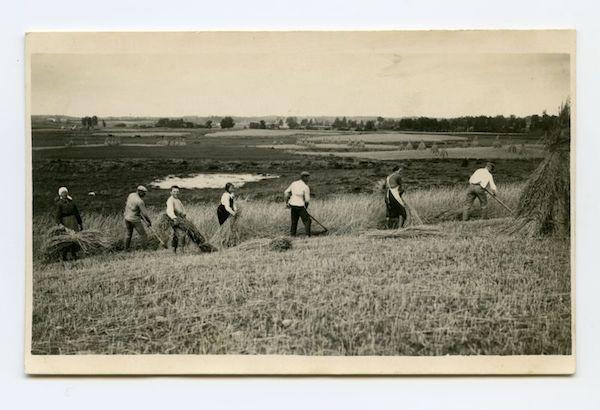
Harvesting rye with scythes in Juodėnai village, Lithuania. Original photograph Povilas Butkus, 1938.
In the summertime, we frequently visited with our relatives in the country. The grownups helped with harvesting and us kids followed them around and entertained ourselves with lighter tasks. My parents, aunts, and uncles all grew up on farms and were used to this type of work. I remember them teasing each other and laughing in the fields. Yet, it was hard work and they were all exhausted by the end of the day.
My own ancestors in Old Lithuania, like ancestral peoples everywhere, must have carried much body wisdom. Working the land shaped their bodies and their posture. Theirs wasn’t just a weekend task: it was a day-by-day, year-after-year way of life.
Photo treasures
Much more recently, I found a treasure trove of photos on E-paveldas. I immediately recognized the pristine body architecture and beautiful movements of the Lithuanian farmers. Here were women and men working with a clear J-shaped spine — which is found in highly functioning and musculoskeletally sound populations and is a cornerstone of the Gokhale Method. I was not surprised to see the J-spine show up in historical photos from Lithuania. How else could one exert oneself on a daily basis and remain productive and intact?
Before machinery, harvesting was a communal affair. Men did most of the chopping, plowing, and scything. Women raked and gathered, but also did heavier work when needed. Hay and grain harvesting was done with scythes. When harvesting grain, as in both photographs above, the cuttings were gathered and bundled into neat bunches and stacked in big piles in the fields. If harvesting hay, the cuttings were first spread out to dry and once dry, the hay was gathered and transported to the barns (below).
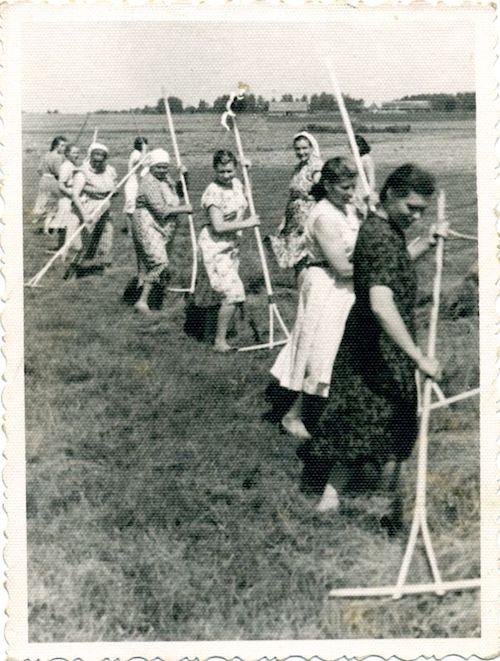
Young women from Didsodė village harvesting hay. Original photographer unknown, ca. 1940.
In the picture below, we see women hefting piles of dry hay to load up a horse cart.
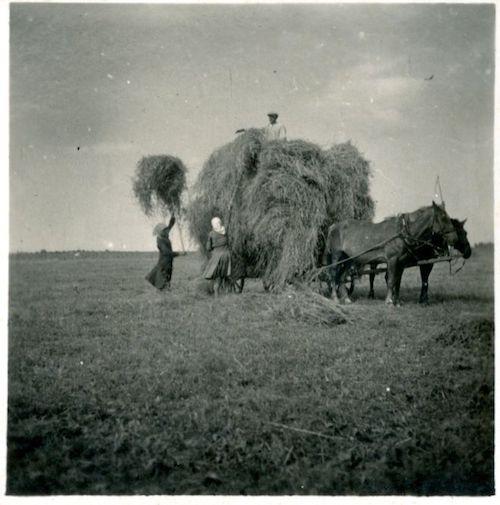
Women loading harvested and dried hay onto a horse cart. Original photographer unknown, 1935.
Postural highlights
These old photographs give us a good view of people’s silhouettes. In contrast to modern-day postural tendencies in industrialized societies, there is no tucking of the pelvis. Behinds are very much behind. Shoulders are back and necks are lengthened. That’s J-spine, the same spinal shape we all had when we were little!
This body architecture sets a foundation for inner corset engagement. Here, the obliques, transverse abdominis, rotatores, and multifidi muscles are all engaged.
The inner corset muscles stabilize and decompress the spine so there is no wear and tear on spinal structures during exertion. This is how repetitively thrusting with pitchforks, lifting weights over the head, forcefully swinging scythes across the body, or reaching and pulling with rakes can be performed without hurting one’s back. Of course, the inner corset muscles get a huge workout! Meanwhile, they become stronger and in turn better support the spine.
Additionally, heavy arm and shoulder actions require correct shoulder placement. Notice that the farmers’ chests are open and wide, and shoulders are set further back. This shoulder location allows for better arm circulation, opens the chest cavity for better breathing, and prevents the upper spine from slumping. This position is key for efficient movement and protection from injury.
Bending well is essential to avoid back pain. You can see all the women hinging beautifully from their hips and keeping their backs flat while harvesting potatoes, doing laundry, and cooking. In spite of long hours bending, they did not hunch their shoulders, round their backs, or distort their spines.
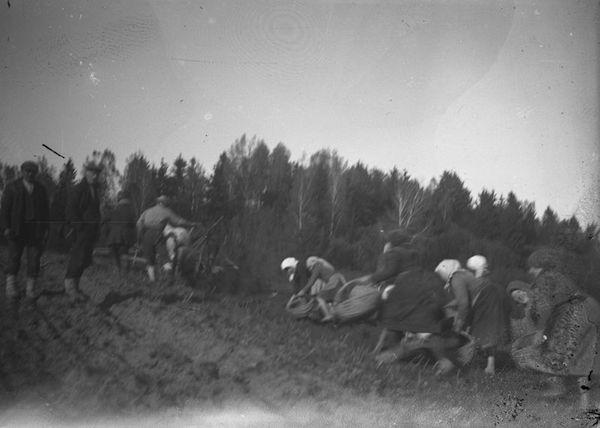
Potato harvest in the Džiuginėnai fields. Original photograph Juzefas Perkovskis, 1940.
This healthy way of bending does no damage to the bones, discs or ligaments. Instead, it strengthens the muscles in the back (erectors and rhomboids) and provides the best stretch for the leg and hip muscles (external hip rotators and hamstrings).
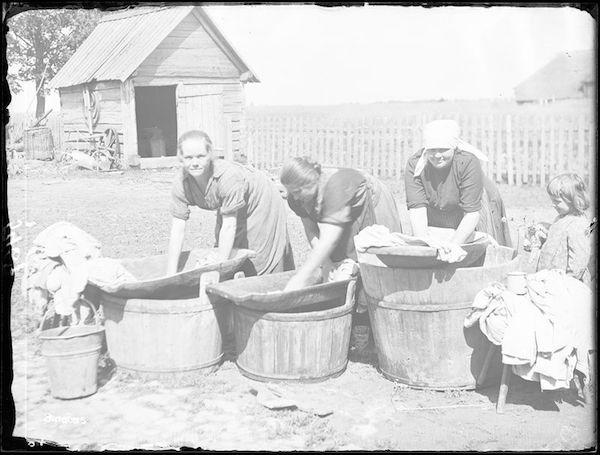
Women hip-hinging while doing laundry. Original photograph Balys Buračas, 1923.

Hip-hinging while cooking in an open-air summer kitchen. Original photograph Stasys Vaitkus, 1937.
Another beautiful image (below) depicts three shepherd boys with their instruments. Notice that their lengthened leg and hip muscles in turn allow the spine to stack without slumping even when squatting on the ground. Their legs remain externally rotated, and their foot arches intact.
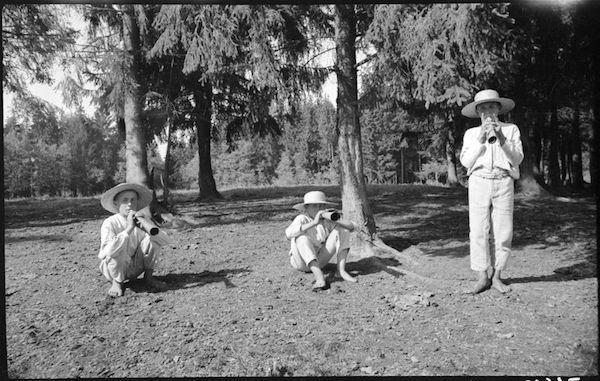
Village shepherds. Note the deep, healthy squat at left. Original photograph Stasys Vaitkus, 1938.
In the last image (below), an older couple carries a yoke (naščiai) and baskets. What a clever way to carry a load! The yoke is placed close to the spine — the best place to bear weight, just like in weight lifting, while arms and hands are spared.
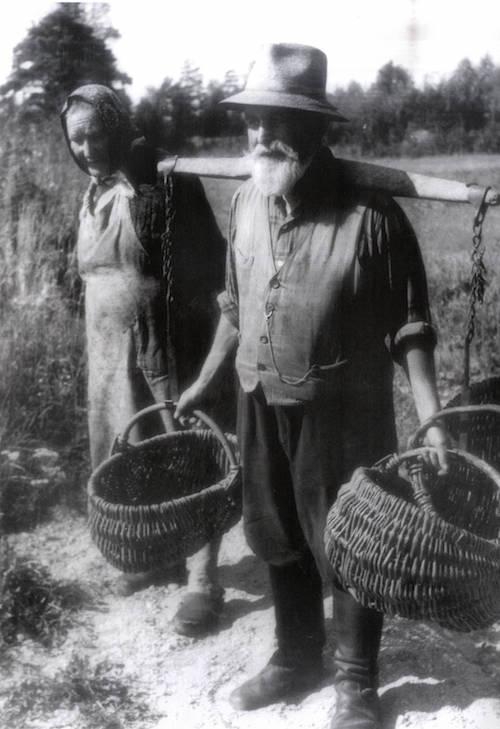
Marija and Augustas Šarkai on their way to harvest potatoes. Group Photograph/Bernardas Aleknavičius, 1971.
This couple encapsulates what we find across all ancestral populations:
Their feet are turned out and bean-shaped.
Their behinds are behind them.
Their ribcages are flush with the contours of the torsos, which means their lower backs are lengthened.
Their shoulders are set way back and their arms are externally rotated.
Their necks are long; their chins angle down.
Furthermore, this couple is not young anymore. I am sure they worked throughout their lives, yet they retain beautiful, erect posture.
Reflection
This was a brief glimpse of village life in Lithuania in the early twentieth century. The photographs of my ancestors laboring in the fields are brimming with body wisdom. This wisdom is a part of a common worldwide heritage that has been displaced by modern culture. Yet, it is still available to us through photographs, stories from elders, and posture work.
I felt inspired by the wisdom and proud of my Lithuanian heritage when looking at these pictures. I encourage you to do the same! Look through your own family photos, if you have them, or historical photography books. Let these images inspire you and reaffirm how well our bodies are designed, and how sturdy and strong they are when used well.

Comments
Hi Tom, this is Aurelia
Hi Tom, this is Aurelia Vaicekauskas, the Gokhale Method Teacher, I am the author of this article. The credits were listed in the first page of Positive Stance and not in the full document, that's why you missed it,- sorry about that.
I am glad you enjoyed the article!
Aurelia
Very interesting article -
Very interesting article - thank you. Love the hip-hinging! I came across this article which may be of interest to some regaring "squatting":
https://qz.com/quartzy/1121077/to-solve-problems-caused-by-sitting-learn-to-squat/
Hello Christine,What a great
Hello Christine,
What a great article, thank you for sharing!
And talking about Squatting, I can't resist mentioning another article about squatting by Esther Gokhale: https://gokhalemethod.com/blog/67615
Best,
Aurelia
Hi Aurelia, thank you for
Hi Aurelia, what a surprise! Thank you for such an interesting article. I truly enjoyed it. Even more so, while being Lithuanian myself. Greetings! Linkejimai! ~ Jurgita
Kaip malonu, thank you,
Kaip malonu, thank you, Jurgita!
Add New Comment
Login to add commment
Login